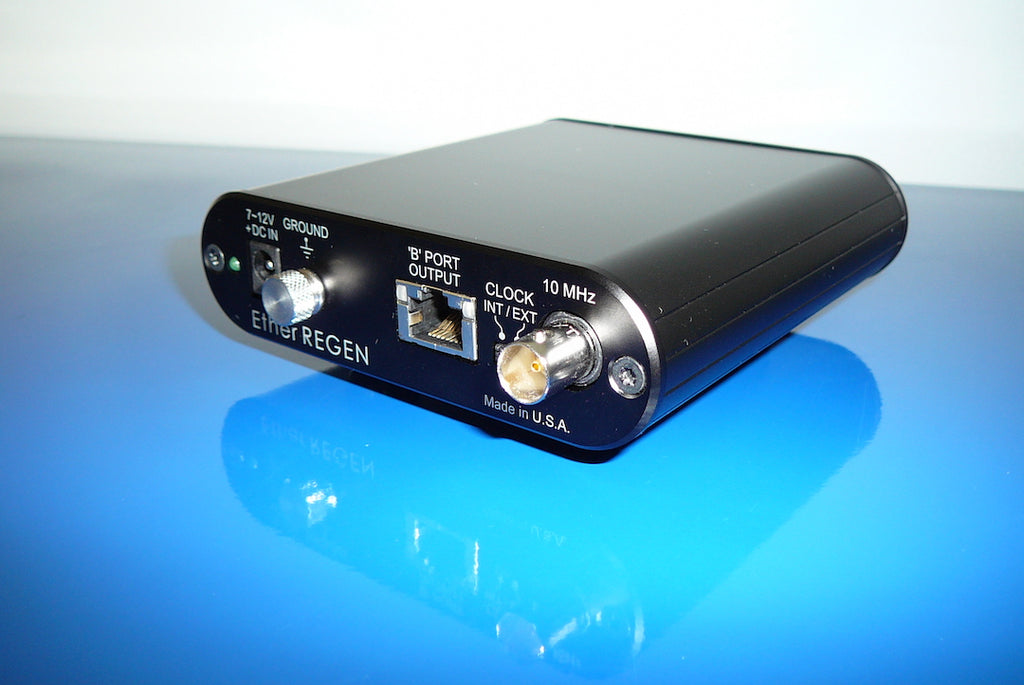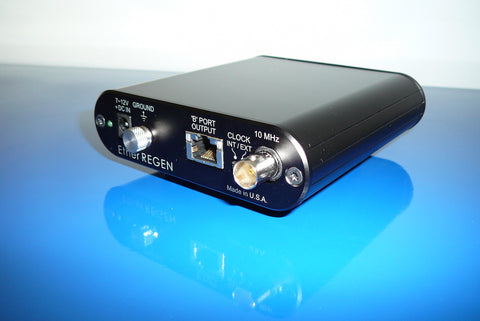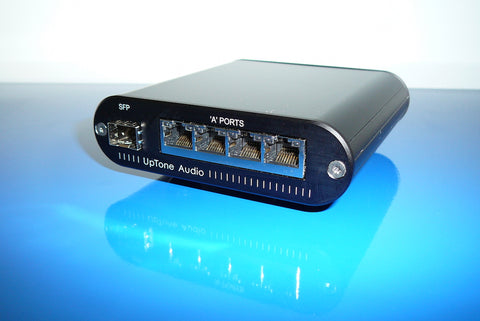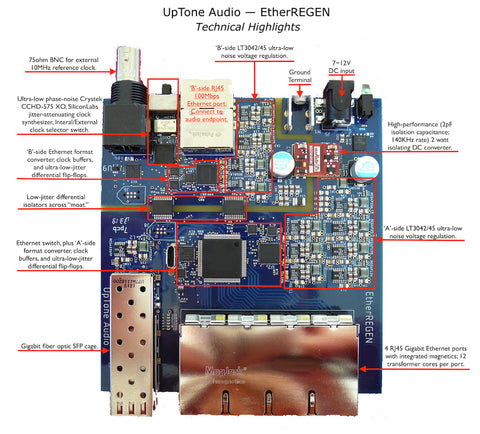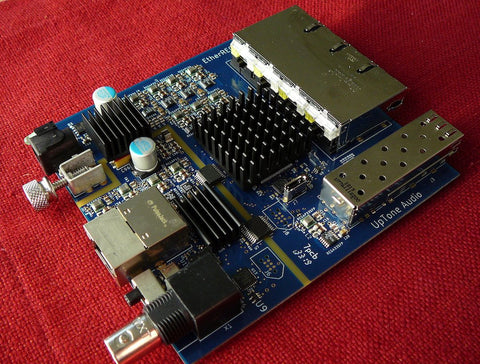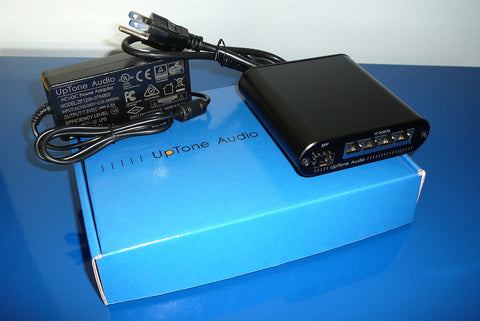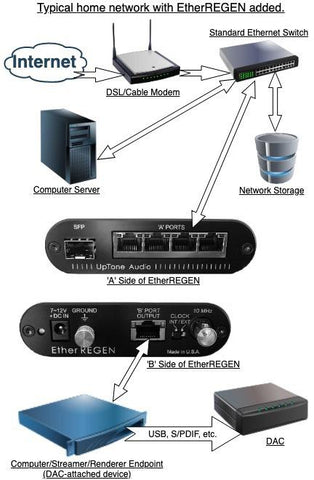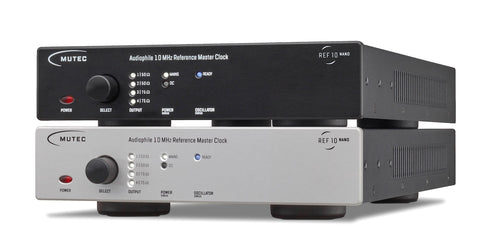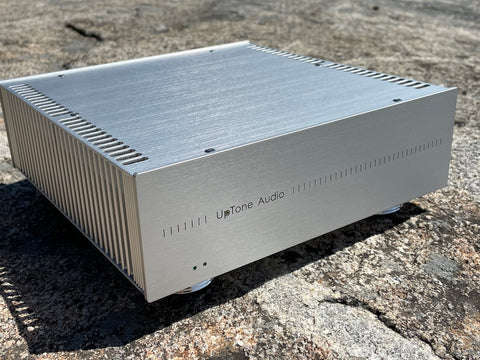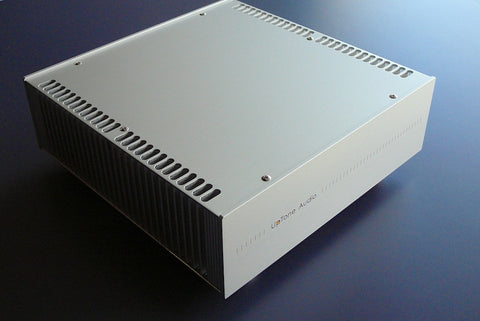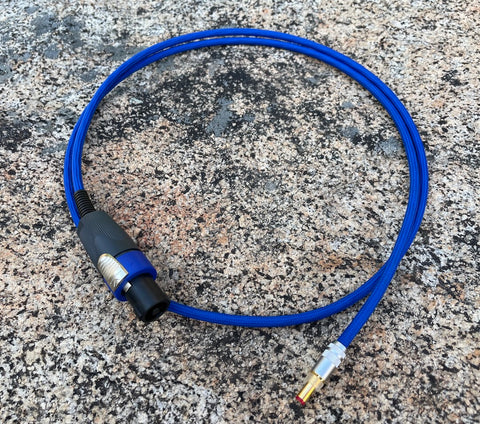EtherREGEN (original, "Gen1")
$ 680.00
UpTone Audio is proud to announce availability of EtherREGEN. In development for nearly two years, this revolutionary and sophisticated Ethernet switch is capable of producing surprisingly audible sonic improvements in fine music systems.
The goals and architecture of the EtherREGEN are completely different than any other Ethernet switch on the planet!
EtherREGEN has become a huge success, with an incredible number of users raving about what they hear. Please check out the Listening Impressions thread at our forum.
Audiophile Style has published a comprehensive feature article review of the EtherREGEN by the popular and thoughtful writer Rajiv Arora (aka 'Austinpop'). It is a long review and worth reading, yet to quote from his summation:
"The UpTone EtherREGEN is one of those rare products that delivers high-end audio performance at an affordable price. Not only does it deliver “surprisingly audible sonic improvements” as claimed, it holds its own against the best-sounding competing products out there, that cost 3x its price or more.... I don’t use the word “bargain” lightly, but in this case it’s true. The EtherREGEN is one of high-end audio’s bargains. If your audio system uses Ethernet for streaming audio, you owe it to yourself to try the EtherREGEN."
An in-depth, seven page review of the EtherREGEN has appeared in the print and online editions of the The Absolute Sound, December 2020. Here is a link to full review: The Absolute Sound EtherREGEN review by Stephen Scharf. That fine review lead to a major award in the category of "Technology Breakthrough."

The well-known Dutch audio reviewer Hans Beekhuyzen posted a detailed video review of the EtherREGEN on his popular YouTube channel. At the end of his review you will see that for him, the EtherREGEN came out on top—versus even a nearly 3x the price competitor!
Of interest to home theater/high-definition video enthusiasts will be this fascinating review with carefully produced photographic proof of the impact the EtherREGEN on imaging performance.
–––––––––––––––––––––––––––––––––––––––––––––––––
Other “audiophile” Ethernet switches typically apply clock and power supply modifications to cheap off-the-shelf switches, or simply add passive filter parts to standard magnetics and augment with a separate fancy clock board. EtherREGEN is an all-new from the ground-up design, built on a costly 6-layer circuit board. Its components and topology are unmatched by any other Ethernet switch.
The heart of what makes our switch so unique is use of ACTIVE, HIGH-SPEED, LOW-JITTER DIFFERENTIAL DIGITAL ISOLATOR chips in conjunction with ULTRA-LOW JITTER DIFFERENTIAL RE-CLOCKING FLIP-FLOPS. No other Ethernet switch on the market does this. Implementing this architecture correctly is difficult and costly!
Going from port-to-port on the ‘A’ side of EtherREGEN is already better than most any other switch, but crossing our Active Differential Isolation Moat (“ADIM™”)—to its ‘B’ side—brings an unmatched level of Ethernet performance for audio. On the circuit board photos you can see the EtherREGEN’s “moat,” across which sit the differential digital isolators.
The design methods and innovative ADIM™ of the EtherREGEN results in dual, isolated clock/data/power domains, blockage of all external leakage currents, a significant reduction in upstream phase-noise fingerprint, and maximal signal integrity.
[Ongoing discussion and questions about EtherREGEN can be found in a long thread at our sponsored forum. And there is an active thread discussing Installation and Usage Questions.
–––––––––––––––––––––––––––––––––––––––––––––––––
Let’s back up a moment to explain the usage and reason for the EtherREGEN:
On the EtherREGEN’s ‘A’-side, there are four Gigabit copper Ethernet ports, plus an SFP cage for a Gigabit LC optical module. A typical user will attach a single Ethernet cable from their main network router or switch to any of these ‘A’-side ports—as illustrated on the opposite page. This leaves open three additional RJ45 copper ports (and the SFP cage) on the ‘A’ side. [The choice to connect any server, NAS (network attached storage), or other devices to these ports—or to leave that equipment attached to your main upstream switch/router—is mostly a matter of convenience and effects on sonic performance are likely to be small.]
Across the ADIM™, at the other end of the EtherREGEN, is a single 100Mbps copper Ethernet port. This is the ‘B’-side port. Attach the computer/streamer/renderer endpoint that is directly connected to your DAC*to the ‘B’-side Ethernet port with a copper Ethernet cable. (*DACs that have an Ethernet input can be directly connected to the ‘B’-side port).
So why does this arrangement matter?
There are two types of sound-degrading influences the EtherREGEN is designed to radically decrease: Leakage—both high-impedance and low-impedance—and clock phase-noise. The clock phase-noise travels on the Ethernet signal itself and on power- and ground-planes. [Every signal edge coming out of any digital device carries the jitter/phase-noise of the clock used to "clock out" that edge; this shows up on the ground-plane and affects the threshold of chips’ clock inputs. This is an oversimplification of a complex subject; here is the link to our 'white paper' about the technical mechanisms (to be followed with some measurement proof of the effects).
The circuitry across the ADIM™ (moat) is designed to eliminate the signal-borne phase-noise from one side to the other. EtherREGEN is mostly symmetrical—there is no “dirty side” or “clean side.” While it works identically in both directions, it is best to have the DAC-attached Ethernet endpoint device (computer/streamer/etc.) alone on one side—typically the ‘B’ side.
The circuitry between ports on the ‘A’ side decreases phase-noise effects to some degree, but not nearly as much as crossing the ‘A’>’B’ moat. It is the differential isolators used in conjunction with the differential flip-flops that delivers the performance of the EtherREGEN. The differential isolators prevent the data-borne clock signature from getting onto the ground-plane of the PCB, while the differential flip-flops prevent the signature from getting into the flip-flop’s own internal ground network. It takes the combination of these to achieve the performance of the EtherREGEN.
–––––––––––––––––––––––––––––––––––––––––––––––––
Back to technical features:
- EtherREGEN has two isolated data/power/clock domains. Each isolated domain is re-clocked using 10GHz-capable ultra-low-jitter (less than 0.8 picoseconds) differential flip-flops.
- The clocking system runs from an advanced, programmable, jitter-attenuating clock synthesizer with four differential outputs. It is referenced to an ultra-low-jitter/phase-noise Crystek CCHD-575 oscillator. Importantly, the clock distribution system (for the switch chip, the special Ethernet format conversion chips, and the high-speed flip-flops) is run differentially throughout. Special conversion buffers are positioned just millimeters from chips that require single-ended clocks.
- Even the magnetics of the four Gigabit ‘A’-side ports are special. We chose an RJ45 module that utilizes 12 transformer cores in each port (most Ethernet ports have 2~6 cores), and ground their center-taps through capacitors in a way that blocks port-to-port AC leakage currents.
- To support its performance, the power networks of the EtherREGEN are as sophisticated and costly as the rest of the design. We use 12 of the world’s lowest-noise, lowest-impedance integrated voltage regulators—the famous Linear Technology LT3045 and LT3042. Supporting both the voltage regulators and the data chips are 195 low-inductance, X7R and X5R capacitors sized and selected by their derating curves.
- The EtherREGEN incorporates two newly introduced Ethernet transceiver chips—one on each side of the ADIM™. These advanced chips were very new at the time of design; UpTone was among the first OEM manufacturers in the world to engineer a product using them.
- The main processor is an advanced, flexible, and fully managed switch processor—with integrated high quality PHYs and support for all current IEEE network protocols.
–––––––––––––––––––––––––––––––––––––––––––––––––
Other specifications:
Dimensions are —112mm x 110mm x 30mm
DC power input range — 7V/1.4A, 9V/1.0A, 12V/0.8A
DC jack size — 5.5mm x 2.1mm, center-positive.
Operating temperature — 48~52C (118~126F)
Here is the link to the EtherREGEN User Guide.
–––––––––––––––––––––––––––––––––––––––––––––––––
Powering the EtherREGEN:
All EtherREGEN units are shipped with a fully certified, world-voltage compatible (100~240VAC), 7.5 volt / 4.8 amp AC>DC adapter. The included detachable 45cm IEC C14 AC mains cord has a USA wall plug. Connect any properly grounded local cord if you reside in a country where a different style of wall plug is used.
Use of a fancy linear power supply is NOT required to get outstanding performance from the EtherREGEN but many users elect to pair one with it. Please use a supply in the +DC 7~12V range.
A note about our inclusion of an SFP cage:
Use of optical into—or out of—EtherREGEN is not required to obtain best performance. The whole point of all the isolation and re-clocking techniques we are using (in dual domains) is to make most all of the upstream stuff not matter. Other than the complete galvanic isolation that optical offers going into the EtherREGEN (which we duplicate going across the moat), there is likely no advantage to running optical into it. If you happen to have a router with an optical port and have already run many feet of optical cable to your music system rack, then sure, use the optical port of the EtherREGEN. But don't go out of your way to run fiber-optic if you do not already have it.
For the few people who have an endpoint with optical input (the excellent Sonore opticalRendu and Lumin X1 come to mind), one can “turn around” the EtherREGEN and feed that DAC-connected endpoint from the optical cage, while connecting the lone ‘B’-side port to the network. Thus ‘B’ >’A’.
Only Gigabit LC-optical or copper interface modules are compatible with the SFP cage of the EtherREGEN. They can be SX multi-mode, LX multi-mode, or LX single-mode, as long as they are Gigabit and match what is used at the other end of the optical cable.
Extreme usage with an External Reference Clock:
The Crystek CCHD-575 oscillator used in the EtherREGEN is one of the lowest phase-noise production crystal oscillators (XO) available. [Sorry, but the $50~$100 OCXOs we see tossed into stock switches do not outperform the Crystek at low-offsets where it counts; Manufacturers have to spend $500 and up to obtain OCXO clocks with significantly lower phase-noise than the Crystek we use.]
Yet many audiophiles have discovered benefits using expensive ultra-low-jitter/low-phase-noise 10MHz reference clocks with their DACs or USB streamers and conditioners. A clock synthesizer (to generate the various frequencies) is always required for a device to accept an external reference clock. Since we already utilize a very advanced one to produce the 4 clock lines in the EtherREGEN, it was easy for us to include provision for connection of an external 10MHz clock. The BNC jack and termination resistor of the EtherREGEN are for a 75ohm clock line.
We can provide units with 50ohm, but only upon special request. Impedance matching of clock/cable/device matters only when using a square wave clock; it does not matter at all when using a sine wave clock. EtherREGEN accepts both sine and square wave 10MHz external clock.
For more on this subject please read our paper on the subject of sine versus square and the considerations of clock cables and impedance.
–––––––––––––––––––––––––––––––––––––––––––––––––
The EtherREGEN includes personal and responsive support, along with a 30-day money-back satisfaction guaranteed and a 2-year warranty.

